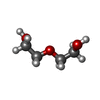+Search query
-Structure paper
| Title | Small-molecule positive allosteric modulation of homomeric kainate receptors GluK1-3: development of screening assays and insight into GluK3 structure. |
|---|---|
| Journal, issue, pages | FEBS J, Vol. 291, Issue 7, Page 1506-1529, Year 2024 |
| Publish date | Feb 23, 2024 |
 Authors Authors | Yasmin Bay / Raminta Venskutonytė / Stine M Frantsen / Thor S Thorsen / Maria Musgaard / Karla Frydenvang / Pierre Francotte / Bernard Pirotte / Philip C Biggin / Anders S Kristensen / Thomas Boesen / Darryl S Pickering / Michael Gajhede / Jette S Kastrup /    |
| PubMed Abstract | The kainate receptors GluK1-3 (glutamate receptor ionotropic, kainate receptors 1-3) belong to the family of ionotropic glutamate receptors and are essential for fast excitatory neurotransmission in ...The kainate receptors GluK1-3 (glutamate receptor ionotropic, kainate receptors 1-3) belong to the family of ionotropic glutamate receptors and are essential for fast excitatory neurotransmission in the brain, and are associated with neurological and psychiatric diseases. How these receptors can be modulated by small-molecule agents is not well understood, especially for GluK3. We show that the positive allosteric modulator BPAM344 can be used to establish robust calcium-sensitive fluorescence-based assays to test agonists, antagonists, and positive allosteric modulators of GluK1-3. The half-maximal effective concentration (EC) of BPAM344 for potentiating the response of 100 μm kainate was determined to be 26.3 μm for GluK1, 75.4 μm for GluK2, and 639 μm for GluK3. Domoate was found to be a potent agonist for GluK1 and GluK2, with an EC of 0.77 and 1.33 μm, respectively, upon co-application of 150 μm BPAM344. At GluK3, domoate acts as a very weak agonist or antagonist with a half-maximal inhibitory concentration (IC) of 14.5 μm, in presence of 500 μm BPAM344 and 100 μm kainate for competition binding. Using H523A-mutated GluK3, we determined the first dimeric structure of the ligand-binding domain by X-ray crystallography, allowing location of BPAM344, as well as zinc-, sodium-, and chloride-ion binding sites at the dimer interface. Molecular dynamics simulations support the stability of the ion sites as well as the involvement of Asp761, Asp790, and Glu797 in the binding of zinc ions. Using electron microscopy, we show that, in presence of glutamate and BPAM344, full-length GluK3 adopts a dimer-of-dimers arrangement. |
 External links External links |  FEBS J / FEBS J /  PubMed:38145505 PubMed:38145505 |
| Methods | EM (single particle) / X-ray diffraction |
| Resolution | 2.7 - 6.61 Å |
| Structure data |  EMDB-15985: Small molecule positive allosteric modulation of homomeric kainate receptors GluK1-3: Development of screening assays and insight into GluK3 structure  EMDB-15986: Ionotropic glutamate receptor K3 with glutamate and BPAM  PDB-8bst: |
| Chemicals |  ChemComp-ACT:  ChemComp-ZN:  ChemComp-CL:  ChemComp-SO4:  ChemComp-PEG:  ChemComp-KAI:  ChemComp-GOL:  ChemComp-HOH: |
| Source |
|
 Keywords Keywords |  MEMBRANE PROTEIN / MEMBRANE PROTEIN /  IONOTROPIC GLUTAMATE RECEPTOR / GLUK3 LIGAND-BINDING DOMAIN / GluK3-M523A-LBD IONOTROPIC GLUTAMATE RECEPTOR / GLUK3 LIGAND-BINDING DOMAIN / GluK3-M523A-LBD |
 Movie
Movie Controller
Controller Structure viewers
Structure viewers About Yorodumi Papers
About Yorodumi Papers





